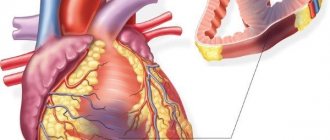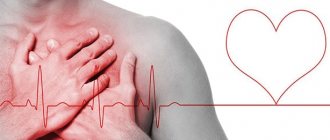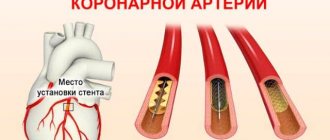Etiology
The reasons for the progression of myocardial dystrophy are quite varied. They are divided into factors that directly affect the functioning of the heart and causes that do not directly affect the organ (act through external factors).
The first group of reasons include:
- decreased oxygen uptake by the heart;
- increased levels of calcium in the ventricles of the heart;
- damage to the myocardium by fat cells;
- destruction of the organ structure by pathogenic bacteria;
- reduction of working cells in the heart due to the effects of other pathogenic processes.
The second group includes:
- the effect of hormones on the muscle layer of the heart;
- all kinds of acute poisoning of the body (drugs, alcoholic drinks, nicotine, medications);
- the effect of a large dose of radiation on the body;
- prolonged stress, depression, apathy;
- greater physical activity leads to the detection of such a disease in athletes;
- unhealthy diet, which mostly consists of very fatty and salty foods;
- abnormal functioning of the organs of the endocrine and digestive systems.
ACQUIRED CARBOHYDRATE DYSTROPHIES
Hypoglycemia is a condition characterized by a decrease in blood glucose below 65 mg%, or 3.58 mmol/l. Normally, fasting blood glucose levels range from 65-110 mg%, or 3.58-6.05 mmol/l.
The causes of hypoglucemia are liver diseases - chronic hepatitis, cirrhosis of the liver, fatty degeneration, as well as prolonged fasting.
Disease results:
- impaired transport of glucose from the blood to hepatocytes, a decrease in the level of formation of glycogenesis in them and, in connection with this, the absence of stored glycogen;
- inhibition of the process of glycogen formation and glucose transport from hepatocytes to the blood.
Consequences of hypoglycemia
- Hypoglycemic syndrome is a persistent decrease in blood glucose levels below normal (up to 60-50 mg%, or 3.3-2.5 mmol/l), leading to disruption of the body's vital functions.
- Hypoglycemic coma is a condition characterized by: - a drop in blood glucose concentration below 40-30 mg%, or 2.0-1.5 mmol/l);
- — loss of consciousness;
- - life-threatening disorders of body functions.
Hyperglycemia is a condition characterized by an increase
blood glucose levels are higher than normal (more than 120 mg%, or 6.05 mmol/l on an empty stomach).
Causes of hyperglycemia:
- pathology of the endocrine system, accompanied by an excess of hormones that stimulate the flow of carbohydrates into the blood (glucagon, glucocorticoids, catecholamines, thyroid hormones, growth hormone) or a lack of insulin or a decrease in its effectiveness;
- neuro- and psychogenic disorders, for example reactive psychoses, stress reactions and similar conditions, characterized by activation of the endocrine system;
- overeating, especially long-term excessive consumption of confectionery products;
- liver diseases in which hepatocytes lose the ability to transform glucose into glycogen.
Consequences
- Hyperglycemic syndrome is a condition accompanied by a significant increase in blood glucose levels above normal (up to 190-210 mg%, 10.5-11.5 mmol/l or more), leading to disorders of the body's vital functions.
- Hyperglycemic coma , characterized by loss of consciousness, decreased or loss of reflexes, respiratory and circulatory disorders, often ending in the death of the patient.
Most often, hyperglycemia is observed in diabetes mellitus, which develops as a result of absolute or relative insulin deficiency (see Chapter 19).
Varieties
Depending on the causes of occurrence and symptoms manifested, myocardial dystrophy can be:
- ischemic - formed due to the entry of insufficient air into the myocardium. Rarely, a blood clot is found in the arteries that supply oxygen to the muscle;
- focal. The main reason for the appearance lies in the disruption of blood circulation in the arteries connected to the muscle. There have been cases of the disease occurring without symptoms. For such people, even heart attacks were painless;
- fatty – is formed diffusely, i.e. due to the accumulation of a small amount of fat in myocardial cells (cardiomyocytes). Gradually, the level of fat increases and eventually it completely replaces the cytoplasm. The main reason for the development of this type of disease is insufficient consumption of proteins and vitamins;
- dishormonal - appears as a result of hormonal imbalance in the body. Mostly women are affected during the cessation of menstruation or other gynecological problems. In men, it is associated with impaired production of the hormone testosterone;
- left ventricle of the heart. This type of disease is not independent, but occurs against the background of some disease;
- toxic – appears in people suffering from alcohol addiction;
- physical stress – athletes are susceptible due to poor blood circulation. In professional athletes, cardiac muscle cells are replaced by connective tissue that is not designed to stretch.
Structure of the heart wall
Dystrophic changes in the muscles of the heart are divided into several stages of development:
- primary – characterized by painful attacks in the heart area, shortness of breath and a rapid decrease in energy, without exposure to physical activity. At this stage, there is a possibility of an increase in the size of the heart. It is impossible to cure;
- second stage - there is a disturbance in the heart rhythm and swelling of the extremities, which are almost invisible. When the heart contracts, it pumps less blood than what it receives when it relaxes. With adequate and timely treatment, there is a chance of restoring healthy heart function;
- the last - this stage is characterized by a lack of air not only in movement, but also at rest, and a decrease in the patient’s ability to work. The heart does not pump as much blood as it does during normal operation. This stage is irreversible.
CARBOHYDRATE DYSTROPHIES
Carbohydrate dystrophies are associated with the accumulation of protein-polysaccharide complexes (glycogen, glycoproteins) in cells, or with the formation of these substances in those cells where they are not normally present, or with a change in their chemical composition.
Carbohydrates are an essential and most significant component of food. A person consumes 400-600 g of various carbohydrates per day. They are a necessary element of metabolism, an important component of the structure of cells and intercellular substances, and one of the main sources of energy to ensure the vital functions of the body.
Symptoms
If the disease was not diagnosed at a young age, then most likely it proceeded without symptoms, which is why the patient did not consult a doctor. But basically, the disease does not go away without expressing signs. The main symptoms of myocardial dystrophy include:
- angina pectoris;
- increased blood pressure;
- feeling of lack of air;
- constant feeling of fear and insecurity;
- heart rhythm disturbance. It is observed very often with focal dystrophy;
- swelling of the lower extremities;
- decreased ability to work;
- high fatigue;
- sleep disturbance;
- increased level of sweating;
- weight loss;
- irritability of the patient;
- shortness of breath at rest;
- spreading pain over the entire left side of the body.
Prevention
Myocardial dystrophy can be prevented. For this purpose, various preventive techniques are used.
In order to prevent the disease it is necessary:
- exclude the use of medications in large quantities;
- avoid excessive consumption of alcoholic beverages;
- daily physical exercise as indicated;
- prevent hypothermia of the body;
- undergo a medical examination at least twice a year;
- consume proteins and vitamins;
- do not drink excessive fluids
And now in more detail about prevention. If you use medications, it is important to use them as directed.
Medicines should be taken according to the instructions. Only this will help prevent possible complications and side effects!
Excessive alcohol consumption can adversely affect the functioning of the heart. It is known that excessive consumption of alcoholic beverages reduces the supply of oxygen to the heart muscle.
If you engage in physical exercise, it is important not to overuse it. It is necessary to calculate the loads correctly. And it is better to practice under the supervision of a specialist.
Hypothermia of the body is also not acceptable. Since large temperature changes and impaired hemostasis of the body lead to pathological changes.
It is best to have annual medical examinations. This will reduce the risk of developing all kinds of pathologies. And it will help prevent the disease at an early stage.
It is best to give preference to vitamins in your diet. Do not under any circumstances give up protein foods. It saturates the body, and vitamins strengthen the immune system.
It is best to consume liquid in a certain amount. In order to reduce the risk of edema. The liquid is consumed in the amount of one liter per day.
go to top
Diagnostics
At the first appointment with the doctor, the patient’s complaints are clarified in detail and a full examination is carried out. Since in some cases the disease may occur without symptoms, additional instrumental techniques will be needed for diagnosis:
- MRI of the heart;
- radiography;
- Ultrasound of the heart;
- phonocardiography. Makes it possible to detect minor heart murmurs;
- electrocardiography – detects abnormalities of the heart at any level;
- biopsy.
Causes
Changes in the functioning of the heart occur for several reasons related to sports activities. This:
- Frequent stress on the body due to training and preparation for serious competitions. Usually people, wanting to win, do not spare themselves and their bodies by exercising too much time. If we take into account not very good nutrition and lack of sleep and rest, then everything goes to the point that sooner or later the heart will begin to “protest” against this way of life. To prevent this, you should not torture yourself before the competition, exhausting yourself with back-breaking exercises without proper rest. Still, health is more important and should always come first. The healthiest and most resilient win, so it makes sense to take care of yourself before a serious event.
- Intense sports activities in physically unprepared people. If the body has not previously received such loads, then immediately excessive training can seriously damage the heart, since it will not cope with such rapid changes. The same applies when a person changes his sport and immediately begins to actively train in something in which he is still weak. To prevent overload on the heart, any vigorous activity should be started gradually, increasing the intensity.
- A combination of intense sports with strenuous work or other intellectual activities. A direct blow to the physical and mental areas of the human body can lead to malfunctions and even an emotional breakdown. The same applies to playing sports immediately after an infectious disease, such as tonsillitis, flu, etc.
Treatment
Treatment of myocardial dystrophy is primarily based on eliminating the sources of its occurrence. Depending on the factors of occurrence and the general health of the patient, doctors prescribe:
- taking medications to normalize heart function;
- hormonal drugs;
- vitamin injections.
Medications are aimed at normalizing heart rhythm. Because the reasons for the formation of the disease are purely personal, this group of drugs is prescribed by doctors purely individually.
Therapy at home is prohibited. These methods can only worsen the course of the disease and increase the risk of complications. And what began as a slight disruption of the heart can become an incurable process of dystrophic thinning of the myocardium.
Treatment of the disease with surgical intervention is almost never practiced, because medications are fully capable of reducing the manifestation or completely eliminating the symptoms of the disease. Heart surgery is performed only when signs of severe heart failure are detected:
- heart rhythm disturbance;
- shortness of breath is not accompanied by physical activity;
- constant swelling of the limbs.
Forecast
Myocardial dystrophy can be completely restored if the cause of the disease is treatable and therapy is carried out before the onset of severe cardiac dysfunction.
In the case of severe cardiac output impairment, the prognosis is unfavorable - patients die within 1–2 years, even with treatment. Without therapy, patients do not survive for years.
Myocardial dystrophy can occur in an acute form, quickly leading to impaired cardiac function, and cause sudden death (athletes during or immediately after training). In this case, a lack of oxygen occurs in the myocardium, the electrolyte composition of the cells changes and the conduction of excitation through the conduction system is disrupted - the heart stops.
okardio.com











